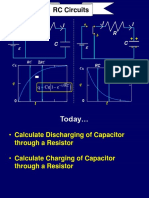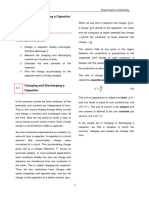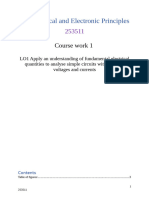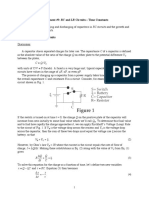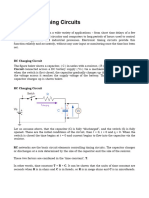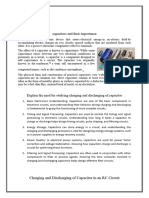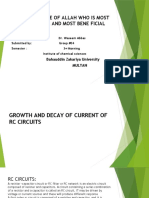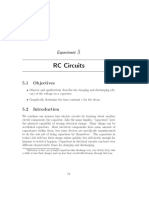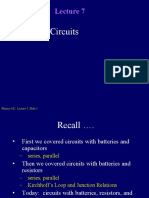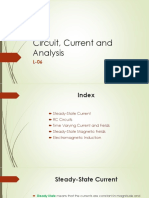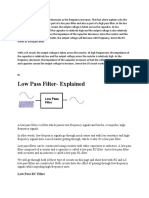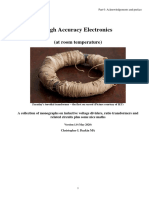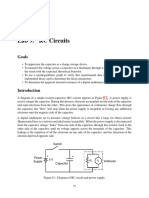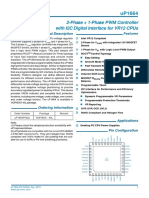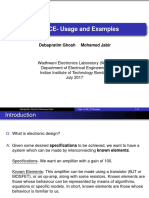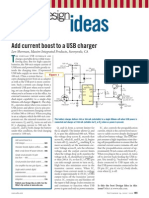Capacitor Charging,
Discharging, and RC series Circuits
Week#11 & 12
Quote of the Day
“Learning never exhausts the mind.”
Leonardo da Vinci
NOTE: Content and Figures are from , Circuit Analysis Theory and Practice, 3e by Robbin
and Miller
� Content
OUTLINE
Introduction
Capacitor Charging Behavior (Voltage and Current)
Capacitor Discharging Behavior (Voltage and
Current)
Capacitor’s RC Time Constant
Capacitor Charging Equations with zero initial
voltage
Capacitor with an Initial Voltage
Capacitor Discharging Equations
More Complex RC Circuits
Capacitor Steady State Analysis
2
� 11.1 Introduction
A simple RC circuit with a switch is shown in Figure 11–1. Most of
the key ideas concerning charging and discharging and dc
transients in RC circuits can be developed from this figure shown
below.
3
� The Time Constant
• The rate at which a capacitor charges from 0v to the maximum
voltage E depends on the product of R and C of the circuit.
This product is known as the time constant of the circuit and
is given the “τ” symbol τ (the Greek letter tau). Time constant
has the units of seconds.
Thus,
• Practically 5τ time is required to charge
the capacitor completely,
And same 5τ time is required to discharge
the capacitor completely.
4
� Capacitor Charging
First, assume the capacitor is uncharged and that the switch is open. Now move the switch to
the charge position, Figure 11–2(a), the voltage which is zero at the instant the switch is
closed gradually climbs to E volts. while the current jumps to E/R amps at the instant the
switch is closed, then decays to zero. This is shown in (b) and (c).
5
� Capacitor Charging (Voltage)
First, consider voltage. In order to change capacitor voltage,
electrons
must be moved from one plate to the other. Even for a relatively
small capacitor, billions of electrons must be moved. This takes
time. Consequently, capacitor voltage cannot change
instantaneously, i.e., it cannot jump abruptly from one value to
another. Instead, it climbs gradually and smoothly as illustrated
in graph of Figure 11–2(b).
6
� Capacitor Charging (Current)
• Now consider current, As indicated in Figure 11–2(c), this
current jumps abruptly from 0 amps to E/R amps(maximum
value), as initially capacitor voltage is 0 volts, so current in
circuit will be E/R only. To understand why, consider Figure 11–
3(a). Since capacitor voltage cannot change instantaneously,
its value just after the switch is closed will be the same as it
was just before the switch is closed, namely 0 V. Since the
voltage across the capacitor just after the switch is closed is
zero. The capacitor looks momentarily like a short circuit. This
is indicated in (b). Applying Ohm’s law yields i = E/R amps.
C
This agrees with what we indicated in Figure 11–2(c).
7
� Capacitor behaver's as Short circuit at switching
This is an important observation and is true in
general, that is,
an uncharged capacitor looks like a short circuit
at the instant of switching.
Time t=0 is the first instant as the switch is
closed, capacitor voltage is 0v and current will
be maximum in the circuit i.e
ic = E/R amps, which is actually the total circuit
current.
8
� Capacitor Discharging
Now consider the discharge case, Figures 11–5. First, assume the
capacitor is charged to E volts and that the switch is open and voltage
source is removed and shortened, Figure 11–5(a). Now close the switch.
Since the capacitor has E volts across it just before the switch is closed,
and since its voltage cannot change instantaneously, it will still have E
volts across, this is indicated in (b). The capacitor therefore looks
momentarily like a voltage source, (c) and the current thus jumps
immediately to E/R amps. (Note that the current is negative since it is
opposite in direction to the reference arrow.)
9
� Capacitor Discharging (Voltage and Current)
At the moment when switch is
moved to discharge position,
vc=E volts, which gradually
reaches to 0v.
and the current at that instant
ic= -E/R amps, which also
reaches to 0 amps as vc
approaches to 0v.
10
� Steady State Conditions
When the capacitor voltage and current reach their final values
and stop changing, the circuit is said to be in steady state.
Figure 11–4(a) shows the circuit after it has reached steady state.
Note that
vC = E and iC =0.
Since the capacitor has voltage across it but no current through
it, it looks like an open circuit as indicated in (b). This is also an
important observation and one that is true in general, that is, a
capacitor looks like an open circuit to steady state dc.
11
� Key Observations
When the switch is at position 1:
At first instant as the switch is closed
Vc = 0 volts and ic = E/R amps and capacitor
behaves like a short circuit initially momentarily.
When the switch is moved to position 2:
Assuming capacitor is fully charged, then at first
instant when switch is moved to position to
Vc = E volts and ic = -E/R amps
Initially an uncharged capacitor behaves
like short circuit.
12
� The Time Constant
• The rate at which a capacitor charges from 0v to the maximum
voltage E depends on the product of R and C of the circuit.
This product is known as the time constant of the circuit and
is given the “τ” symbol τ (the Greek letter tau). Time constant
has the units of seconds.
Thus,
• Practically 5τ time is required to charge
the capacitor completely,
And same 5τ time is required to discharge
the capacitor completely.
13
� EXAMPLE 11–1
For Figure 11–1, E =40 V, R = 10 ohm, and the capacitor s
initially uncharged. The switch is moved to the charge position
and the capacitor allowed to charge fully. Then the switch is
moved to the discharge position and the capacitor allowed to
discharge fully. Sketch the voltages and currents and determine
the values at switching and in steady state.
14
�Solution 11.1
15
�Cont.…
16
�11.1 voltage/current graphs
17
� 11.2 Capacitor Charging Equations
We will now develop equations for voltages and current during
charging.
Consider Figure 11–8. KVL yields
where R is in ohms, C is in farads, t is in seconds and is the
exponential function. The product RC has units of seconds. (This
is left as an exercise for the student to show.)
18
�19
�Duration of a Transient
20
� EXAMPLE 11–2
Suppose E =100 V, R =10 kΩ, and C =10 µF:
a. Determine the expression for vC.
b. Determine the expression for iC.
c. Compute the capacitor voltage at t =150 ms.
d. Compute the capacitor current at t =150 ms.
e. Locate the computed points on the curves.
21
�Cont.…
22
�Cont.…
23
� EXAMPLE 11–4
For the circuit of Figure 11–11, how long will it take for the
capacitor to charge if R =2 kΩ and C =10 µF?
24
�Cont.…
25
� EXAMPLE 11–3
For the circuit of Figure 11–11, E =60 V, R =2 k ohm, and C =25
µF. The switch is closed at t =0 s, opened 40 ms later and left
open.
Determine equations for capacitor voltage and current and plot
26
�EXAMPLE 11–3 Cont.…
27
�EXAMPLE 11–3 Cont.…
28
�29
� 11.3 Capacitor with an Initial Voltage
Suppose a previously charged capacitor has not been discharged
and thus still has voltage on it. Let this voltage be denoted as Vo.
If the capacitor is now placed in a circuit like that in Figure 11–16,
the voltage and current during charging will be affected by the
initial voltage. In this case, Equations 11–7 and 11–8 become
Modified equations will be 11-10 and 11-11 as:
Note that these revert to their original forms when you set Vo= 0 V
30
� EXAMPLE 11–7
Suppose the capacitor of Figure 11–16 has 25 volts on it
with polarity shown at the time the switch is closed.
a. Determine the expression for vC.
b. Determine the expression for iC.
c. Compute vC and iC at t =0.1 s.
d. Sketch vC and iC.
As V0=25 V
31
�Cont.…
32
�11.4 Capacitor Discharging Equations
33
�Capacitor Charging/Discharging Curves
34
� EXAMPLE 11–8
• For the circuit of Figure 11–18, assume the capacitor is
charged to 100 V before the switch is moved to the discharge
position. Suppose R =5 kΩ and C =25 µF. After the switch is
moved to discharge,
a. Determine the expression for vC.
b. Determine the expression for iC.
c. Compute the voltage and current at 0.375 s.
35
� 11.5 More Complex RC Circuits
• The charge and discharge equations described previously
apply only to series RC circuits of the forms shown in Figures
11–2 and 11–5 respectively. Fortunately, many circuits can be
reduced to these forms using standard circuit reduction
techniques such as series and parallel combinations, source
conversions, Thévenin’s theorem, and so on. Once a circuit
has been reduced to its series equivalent, you can use any of
the equations that we have developed so far.
• Charging Circuit 11.2 Discharging Circuit
11.5
36
� EXAMPLE 11–9
• For the circuit of Figure 11–20(a), determine expressions
for v and i . Capacitors are initially uncharged.
C C
37

